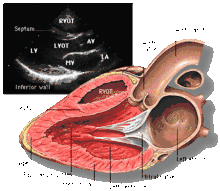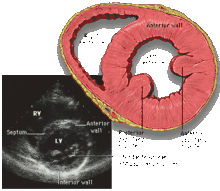Focus assessed transthoracic echocardiography
Focus assessed transthoracic echocardiography (or FATE) is a type of transthoracic echocardiogram, or sonogram of the heart, often performed by non-cardiologist. The protocol has been used since 1989 and has four projections; subcostal four-chamber, apical four-chamber, parasternal long axis and parasternal short axis.
| Focus assessed transthoracic echocardiography | |
|---|---|
| Purpose | type of transthoracic echocardiogram, |
The original focused cardiac ultrasound protocol for non-cardiologists was devised by Dr Erik Sloth in 1989 and has formed the basis of hands-on FATE courses ever since.
The success of the original protocol has inspired a surge of replicas in many shapes and the coining of many imaginative acronyms: FEER, FEEL, Focus, Bleep, HART, FUSE etc. These are all variations of the original theme.
Gallery
 |  |  |  | ]] | |||||||
| Each figure contains a TTE with a black background, and a corresponding colored illustration. | Patrick J. Lynch and C. Carl Jaffe, Yale University, 2006. | ||||||||||
| Click on a figure to enlarge it and see some parts of the heart identified. RV, right ventricle; LV, left ventricle; RA, right atrium; LA, left atrium; TV, tricuspid valve; MV, mitral valve; AV, aortic valve; RVOT, right ventricular outflow tract; LVOT, left ventricular outflow tract | |||||||||||
gollark: If you could somehow make medicine/law available as undergraduate things that... might help?
gollark: The UK does those, I think, and seems to be doing fine lawyer and doctor-wise.
gollark: A convincing explanation I read of the everyone-has-to-go-to-college thing is that college degrees work as a signal to employers that you have some basic competence at listening independently, doing things for delayed gain later, sort of thing, more than providing any massively work-relevant skills, and it apparently got easier/more popular to get a degree over time, so the *lack* of one works as a signal that you *lack* those basic skills.
gollark: No idea.
gollark: Throwing money at a somewhat broken system can just perpetuate the somewhat broken system and cost a lot.
See also
References
External links
- Official FATE protocol website with downloadable FATE card
This article is issued from Wikipedia. The text is licensed under Creative Commons - Attribution - Sharealike. Additional terms may apply for the media files.